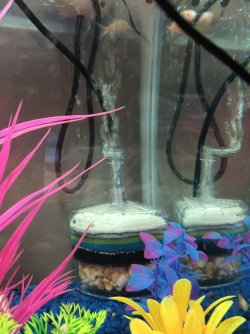You are using an out of date browser. It may not display this or other websites correctly.
You should upgrade or use an alternative browser.
You should upgrade or use an alternative browser.
Corner box filters
- Thread starter 16gallontanker
- Start date
I run DIY versions for fry tanks and also for my frog tank. They're great, reliable filters, but gentle for shrimp, fry, and fish that don't like as much flow.
fishorama
Fish Fanatic
Well, I'm over box filters from more than 40 years ago, lol. I prefer sponge filters in a similar way but haven't used them in a really long time either. With an HOB, I'm good with that in a smaller tank. Your box seems to have more layers than our kind did. Maybe better!?!
I stopped using them years ago, then rediscovered them. They are the mainstay of my fishroom now. I fill them with wide pored sponge so they aren't wasteful (as they are with floss) and make them into little biofilters.
When they were the main filters in the hobby, we didn't understand the cycle and focused on mechanical filtration with them. At that, they weren't great. But if you look at the structure and rethink how they can be effective with what we've learned since then, it's easy to use them.
I have central air in my large fishroom, and by using box filters, I can reduce energy usage radically while still being able to breed and raise delicate species of fish successfully.
Sponge filters are better for strictly biological filtration, but need more air, and at the moment, I'm a little underpowered on that front. I couldn't run 100% sponge filters in the size of set up I have.
I've played with them a lot. I also make my own out of large juice bottles. You have to hide them, but that's easy and they do a very good job.
They are also very good for filtering water through 'botanicals', a useful thing for fish breeders. I have a bale of peat I bought years ago before it was understood to be an ecological problem, and I use it, spaghnum moss, alder cones etc with box filters. They are great little workhorses.
The principle in how they are built is still sound, if they are large enough. What has changed is our understanding of what we want to do with them, and of what filtration actually is doing. As extremely low tech filters, they are also cheap (though not as cheap as they should be - their unpopularity has raised their price ludicrously compared to how simple they are) and will never be marketed as good again. A simple quality airpump with box or sponge filters can run several tanks at a fraction of the cost of several canister filters.
When they were the main filters in the hobby, we didn't understand the cycle and focused on mechanical filtration with them. At that, they weren't great. But if you look at the structure and rethink how they can be effective with what we've learned since then, it's easy to use them.
I have central air in my large fishroom, and by using box filters, I can reduce energy usage radically while still being able to breed and raise delicate species of fish successfully.
Sponge filters are better for strictly biological filtration, but need more air, and at the moment, I'm a little underpowered on that front. I couldn't run 100% sponge filters in the size of set up I have.
I've played with them a lot. I also make my own out of large juice bottles. You have to hide them, but that's easy and they do a very good job.
They are also very good for filtering water through 'botanicals', a useful thing for fish breeders. I have a bale of peat I bought years ago before it was understood to be an ecological problem, and I use it, spaghnum moss, alder cones etc with box filters. They are great little workhorses.
The principle in how they are built is still sound, if they are large enough. What has changed is our understanding of what we want to do with them, and of what filtration actually is doing. As extremely low tech filters, they are also cheap (though not as cheap as they should be - their unpopularity has raised their price ludicrously compared to how simple they are) and will never be marketed as good again. A simple quality airpump with box or sponge filters can run several tanks at a fraction of the cost of several canister filters.
Similar threads
- Replies
- 0
- Views
- 256
- Replies
- 7
- Views
- 206


